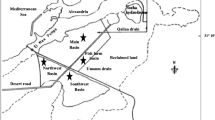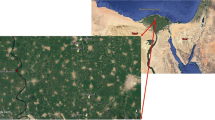Abstract
Heavy metal-polluted wetlands could be remediated by harvesting metal accumulating plants, i.e., using phytoextraction. We studied a macrophyte Phragmites australis and assessed its potential to be utilized in the phytoremediation of heavy metal-polluted wetlands, specifically in wadis in the Arabian Peninsula. We sampled six polluted wadi sites and measured Mn, Fe, Ni, Cu, Zn, Cd, and Pb concentrations in the roots, rhizomes, stems, and leaves of P. australis, as well as in sediment and water. We analyzed the correlations between different plant organs, water, and sediment, and calculated the accumulation and translocation of the metals to the plant organs. We found indications for the accumulation of Cd, Zn, and Pb into P. australis and somewhat contradictory indications for the accumulation of Cu. We suggest that P. australis is a good candidate to be utilized in the phytoremediation of heavy metal-polluted wadis in the Arabian Peninsula where the few wadis offer many valuable ecosystem services for urban citizens.



Similar content being viewed by others
References
Abdel-Baki, A. S., Dkhil, M. A., & Al-Quraishy, S. (2011). Bioaccumulation of some heavy metals in tilapia fish relevant to their concentration in water and sediment of Wadi Hanifah, Saudi Arabia. African Journal of Biotechnology, 10(13), 2541–2547.
Aldjain, I. M., Al-Whaibi, M. H., Al-Showiman, S. S., & Siddiqui, M. H. (2011). Determination of heavy metals in the fruit of date palm growing at different locations of Riyadh. Saudi Journal of Biological Sciences, 18(2), 175–180.
Al-Homaidan, A. A., Al-Ghanayem, A. A., & Alkhalifa, A. H. (2011). Green algae as bioindicators of heavy metal pollution in Wadi Hanifah Stream, Riyadh, Saudi Arabia. International Journal of Water Resources and Arid Environments, 1(1), 10–15.
Ali, H., Khan, E., & Sajad, M. A. (2013). Phytoremediation of heavy metals—concepts and applications. Chemosphere, 91(7), 869–881.
Bonanno, G. (2011). Trace element accumulation and distribution in the organs of Phragmites australis (common reed) and biomonitoring applications. Ecotoxicology and Environmental Safety, 74(4), 1057–1064.
Bonanno, G. (2013). Comparative performance of trace element bioaccumulation and biomonitoring in the plant species Typha domingensis, Phragmites australis and Arundo donax. Ecotoxicology and Environmental Safety, 97, 124–130.
Bonanno, G., & Cirelli, G. L. (2017). Comparative analysis of element concentrations and translocation in three wetland congener plants: Typha domingensis, Typha latifolia and Typha angustifolia. Ecotoxicology and Environmental Safety, 143, 92–101.
Bonanno, G., Vymazal, J., & Cirelli, G. L. (2018). Translocation, accumulation and bioindication of trace elements in wetland plants. Science of the Total Environment, 631, 252–261.
Bounessah, M., Al-Shayeb, S. M., Al-Ghefaili, K. M., & Abdulfatah, B. (2001). Assessment of lead levels in dust and date palm (Phoenix dactylifera L.) in 6-10 year-old school children environment in Riyadh City, Saudi-Arabia. Asian Journal of Chemistry, 13(4), 1435–1442.
Bragato, C., Brix, H., & Malagoli, M. (2006). Accumulation of nutrients and heavy metals in Phragmites australis (Cav.) Trin. ex Steudel and Bolboschoenus maritimus (L.) Palla in a constructed wetland of the Venice lagoon watershed. Environmental Pollution, 144(3), 967–975.
Cicero-Fernández, D., Peña-Fernández, M., Expósito-Camargo, J. A., & Antizar-Ladislao, B. (2017). Long-term (two annual cycles) phytoremediation of heavy metal-contaminated estuarine sediments by Phragmites australis. New Biotechnology, 38, 56–64.
Deng, H., Ye, Z. H., & Wong, M. H. (2004). Accumulation of lead, zinc, copper and cadmium by 12 wetland plant species thriving in metal-contaminated sites in China. Environmental Pollution, 132(1), 29–40.
Du Laing, G., Tack, F. M. G., & Verloo, M. G. (2003). Performance of selected destruction methods for the determination of heavy metals in reed plants (Phragmites australis). Analytica Chimica Acta, 497(1–2), 191–198.
Fahid, M., Arslan, M., Shabir, G., Younus, S., Yasmeen, T., Rizwan, M., et al. (2020). Phragmites australis in combination with hydrocarbons degrading bacteria is a suitable option for remediation of diesel-contaminated water in floating wetlands. Chemosphere, 240, 124890.
Hanfi, M. Y., Mostafa, M. Y. A., & Zhukovsky, M. V. (2020). Heavy metal contamination in urban surface sediments: sources, distribution, contamination control, and remediation. Environmental Monitoring and Assessment, 192(1), 32.
Kabata-Pendias, A. (2010). Trace elements in soils and plants. CRC press.
Khan, M. A., Khan, S., Khan, A., & Alam, M. (2017). Soil contamination with cadmium, consequences and remediation using organic amendments. Science of the Total Environment, 601, 1591–1605.
Klink, A. (2017). A comparison of trace metal bioaccumulation and distribution in Typha latifolia and Phragmites australis: implication for phytoremediation. Environmental Science and Pollution Research, 24(4), 3843–3852.
Klink, A., Polechońska, L., Cegłowska, A., & Stankiewicz, A. (2016). Typha latifolia (broadleaf cattail) as bioindicator of different types of pollution in aquatic ecosystems—application of self-organizing feature map (neural network). Environmental Science and Pollution Research, 23(14), 14078–14086.
Lajayer, B. A., Moghadam, N. K., Maghsoodi, M. R., Ghorbanpour, M., & Kariman, K. (2019). Phytoextraction of heavy metals from contaminated soil, water and atmosphere using ornamental plants: mechanisms and efficiency improvement strategies. Environmental Science and Pollution Research, 26(9), 8468–8484.
Leguizamo, M. A. O., Gómez, W. D. F., & Sarmiento, M. C. G. (2017). Native herbaceous plant species with potential use in phytoremediation of heavy metals, spotlight on wetlands—a review. Chemosphere, 168, 1230–1247.
Maddison, M., Soosaar, K., Mauring, T., & Mander, Ü. (2009). The biomass and nutrient and heavy metal content of cattails and reeds in wastewater treatment wetlands for the production of construction material in Estonia. Desalination, 246(1–3), 120–128.
Mazumdar, K., & Das, S. (2015). Phytoremediation of Pb, Zn, Fe, and Mg with 25 wetland plant species from a paper mill contaminated site in North East India. Environmental Science and Pollution Research, 22(1), 701–710.
Mbanga, O., Ncube, S., Tutu, H., Chimuka, L., & Cukrowska, E. (2019). Mercury accumulation and biotransportation in wetland biota affected by gold mining. Environmental Monitoring and Assessment, 191(3), 186.
Morari, F., Dal Ferro, N., & Cocco, E. (2015). Municipal wastewater treatment with Phragmites australis L. and Typha latifolia L. for irrigation reuse. Boron and heavy metals. Water, Air, & Soil Pollution, 226(3), 56.
Newete, S. W., & Byrne, M. J. (2016). The capacity of aquatic macrophytes for phytoremediation and their disposal with specific reference to water hyacinth. Environmental Science and Pollution Research, 23(11), 10630–10643.
Obolewski, K., SkorbiŁowicz, E., SkorbiŁowicz, M., Glińska-Lewczuk, K., Astel, A. M., & Strzelczak, A. (2011). The effect of metals accumulated in reed (Phragmites australis) on the structure of periphyton. Ecotoxicology and Environmental Safety, 74(4), 558–568.
Phillips, D. P., Human, L. R. D., & Adams, J. B. (2015). Wetland plants as indicators of heavy metal contamination. Marine Pollution Bulletin, 92(1–2), 227–232.
Rai, P. K. (2009). Heavy metal phytoremediation from aquatic ecosystems with special reference to macrophytes. Critical Reviews in Environmental Science and Technology, 39(9), 697–753.
Rezania, S., Park, J., Rupani, P. F., Darajeh, N., Xu, X., & Shahrokhishahraki, R. (2019). Phytoremediation potential and control of Phragmites australis as a green phytomass: an overview. Environmental Science and Pollution Research, 26(8), 7428–7441.
Rzymski, P., Niedzielski, P., Klimaszyk, P., & Poniedziałek, B. (2014). Bioaccumulation of selected metals in bivalves (Unionidae) and Phragmites australis inhabiting a municipal water reservoir. Environmental Monitoring and Assessment, 186(5), 3199–3212.
Salem, Z. B., Laffray, X., Ashoour, A., Ayadi, H., & Aleya, L. (2014). Metal accumulation and distribution in the organs of reeds and cattails in a constructed treatment wetland (Etueffont, France). Ecological Engineering, 64, 1–17.
Scholes, L. N. L., Shutes, R. B. E., Revitt, D. M., Purchase, D., & Forshaw, M. (1999). The removal of urban pollutants by constructed wetlands during wet weather. Water Science and Technology, 40(3), 333–340.
Su, F., Wang, T., Zhang, H., Song, Z., Feng, X., & Zhang, K. (2018). The distribution and enrichment characteristics of copper in soil and Phragmites australis of Liao River estuary wetland. Environmental Monitoring and Assessment, 190(6), 365.
Teuchies, J., Jacobs, S., Oosterlee, L., Bervoets, L., & Meire, P. (2013). Role of plants in metal cycling in a tidal wetland: implications for phytoremidiation. Science of the Total Environment, 445, 146–154.
Verbruggen, N., Hermans, C., & Schat, H. (2009). Molecular mechanisms of metal hyperaccumulation in plants. New Phytologist, 181(4), 759–776.
Vymazal, J. (2016). Concentration is not enough to evaluate accumulation of heavy metals and nutrients in plants. Science of the Total Environment, 544, 495–498.
Vymazal, J., & Březinová, T. (2016). Accumulation of heavy metals in aboveground biomass of Phragmites australis in horizontal flow constructed wetlands for wastewater treatment: a review. Chemical Engineering Journal, 290, 232–242.
Vymazal, J., Švehla, J., Kröpfelová, L., & Chrastný, V. (2007). Trace metals in Phragmites australis and Phalaris arundinacea growing in constructed and natural wetlands. Science of the Total Environment, 380(1–3), 154–162.
Wang, J., & Chen, C. (2009). Biosorbents for heavy metals removal and their future. Biotechnology Advances, 27(2), 195–226.
White, P. J., & Brown, P. H. (2010). Plant nutrition for sustainable development and global health. Annals of Botany, 105(7), 1073–1080.
Funding
This work was supported by King Saud University, Deanship of Scientific Research, College of Science Research Center.
Author information
Authors and Affiliations
Corresponding author
Ethics declarations
Conflict of interests
The authors declare that they have no competing interests.
Additional information
Publisher’s note
Springer Nature remains neutral with regard to jurisdictional claims in published maps and institutional affiliations.
Rights and permissions
About this article
Cite this article
Al-Homaidan, A.A., Al-Otaibi, T., El-Sheikh, M.A. et al. Accumulation of heavy metals in a macrophyte Phragmites australis: implications to phytoremediation in the Arabian Peninsula wadis. Environ Monit Assess 192, 202 (2020). https://doi.org/10.1007/s10661-020-8177-6
Received:
Accepted:
Published:
DOI: https://doi.org/10.1007/s10661-020-8177-6




